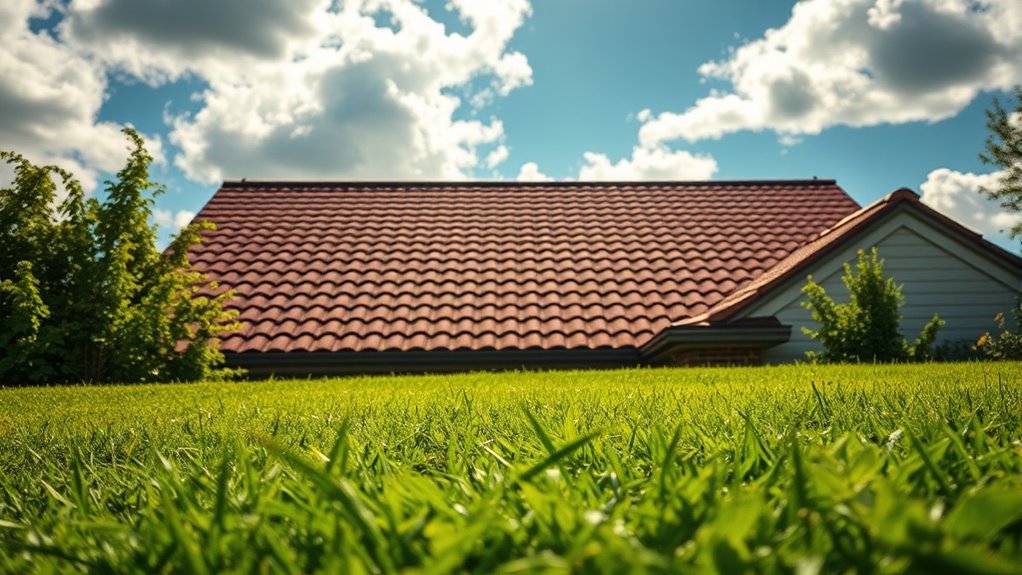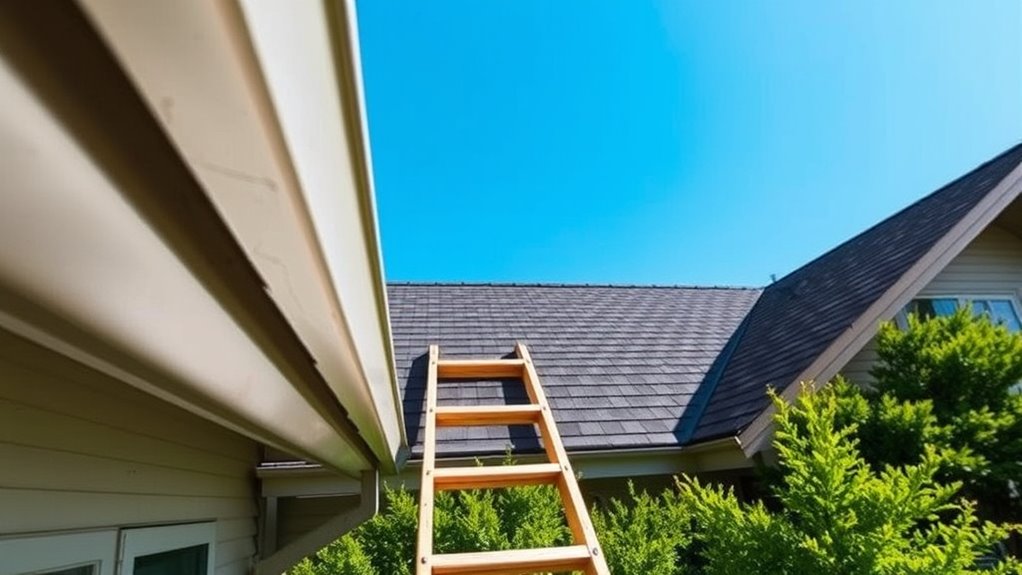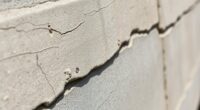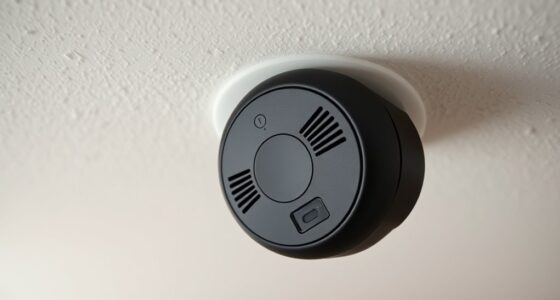To spot trouble early when checking your roof from the ground, look for signs like sagging areas, uneven or deformed shapes, and missing or damaged shingles. Check your gutters for debris, granules, or blockages, which suggest aging or damage. Look for water stains or streaks on exterior walls or ceilings that could indicate leaks. If you notice any of these signs, it’s time to investigate further—continue here to learn more about keeping your roof in good shape.
Key Takeaways
- Observe roof shape for sagging, uneven areas, or deformations from the ground.
- Inspect shingles for missing, cracked, or curling sections without climbing onto the roof.
- Check gutters for debris, blockages, or excessive granules indicating shingle wear.
- Look for water stains or streaks on exterior walls and ceilings as signs of leaks.
- Examine roof edges and flashing for rust, corrosion, or displacement from ground level.

Ever wondered how to evaluate your roof’s condition without climbing up? You can spot potential problems early by paying close attention from the ground. While it might seem challenging to gauge something high above your head, there are several visual cues that can tell you a lot about your roof’s health. Start by standing back and observing your roof’s overall shape and structure. Look for any sagging areas or uneven sections, which might indicate underlying issues like broken trusses or water damage. These signs are often visible from the ground and can prompt a closer inspection or professional assessment.
Next, examine the shingles or roofing material from the ground. Check for missing, cracked, or curling shingles, as these are clear indicators of deterioration. Damaged shingles not only compromise your roof’s waterproofing but also leave it vulnerable to leaks and further damage. Keep an eye out for areas where shingles might be lifting or buckling, which can happen due to high winds or age. If your roof has a different material, such as metal panels, look for signs of rust, dents, or loose sections. Even small issues like granules from asphalt shingles washing into your gutters can hint at aging or wear.
Inspect shingles for missing, cracked, or curling edges and look for rust or dents on metal roofs.
While inspecting from the ground, don’t forget to look at your gutters and downspouts. Blockages or excessive granules in the gutters can signal that your shingles are deteriorating faster than normal. Also, check for debris buildup or sagging gutters, which might point to underlying issues with your roof’s drainage system. Water stains or streaks on your exterior walls or ceiling can also be a sign of leaks, especially after heavy rain. These visual clues are often visible from the ground and can alert you to problems that need prompt attention.
Finally, take a walk around your property to examine the roof’s edges and flashing. Look for any signs of rust, corrosion, or displaced flashing that could let water seep in. If you notice any of these issues, it’s best to contact a roofing professional for a thorough inspection. Regularly evaluating your roof from the ground can save you money and stress by catching trouble early. It’s a simple, effective way to keep your home safe and protected, without risking a dangerous climb or missing subtle warning signs. Additionally, understanding the role of attention in visual inspections helps you focus on key areas that often reveal hidden problems.
Frequently Asked Questions
How Often Should I Perform a Roof Check From the Ground?
You should perform a roof check from the ground at least twice a year, ideally in spring and fall. After severe weather events like storms or heavy winds, check more frequently. Regular inspections help you spot issues early, such as damaged shingles, loose flashing, or debris buildup. Keep an eye out for sagging or water stains on your exterior walls or ceilings, which can indicate hidden leaks. Staying proactive saves you money and prevents major repairs.
Can I Identify All Roof Damages Just by Sight?
No, you can’t identify all roof damages just by sight. While regular visual inspections can reveal obvious issues like missing shingles or sagging, some problems, such as leaks, structural damage, or underlying rot, require closer inspection or professional assessment. Always be cautious and consider a professional roof inspection if you notice any signs of trouble or if you’re unsure about the extent of the damage.
What Tools Are Best for a Ground-Level Roof Inspection?
You should use binoculars or a zoom lens camera for a thorough ground-level roof inspection. Binoculars help you spot damage like missing shingles or sagging areas from afar, while a camera with a good zoom allows you to document issues clearly. A sturdy ladder can also help you get closer if needed, but always prioritize safety. These tools make it easier to identify problems early and decide if professional inspection is necessary.
When Should I Call a Professional After Spotting Issues?
You should call a professional as soon as you spot any signs of trouble, like missing shingles, cracks, or water stains. Don’t wait to see if the problem worsens, since small issues can quickly escalate into costly repairs. Contact a roofing expert promptly to assess the damage and determine the best course of action. Acting quickly helps protect your home and keeps repair costs manageable.
Are Certain Roof Types Easier to Inspect From the Ground?
Yes, certain roof types are easier to inspect from the ground. Asphalt shingles, for example, typically show damage like missing or curling shingles clearly from afar. Metal roofs with standing seams are also relatively simple to spot issues on, as the seams and panels are visible. Slate and tile roofs, however, can be more challenging to assess from the ground due to their textures and angles, requiring closer inspection or professional help.
Conclusion
By keeping an eye on your roof from the ground, you’re like a detective spotting clues before problems grow. Regular inspections help catch issues early, saving you time and money down the road. Remember, a vigilant eye is your best tool—think of it as having a superhero’s vision, spotting trouble before it becomes a big headache. Stay proactive, and your roof will thank you for it, staying strong and secure for years to come.









